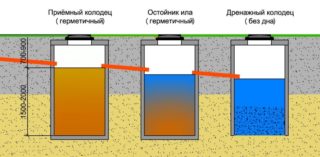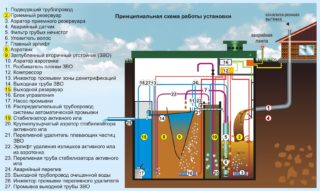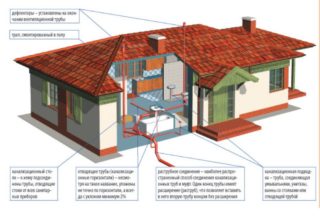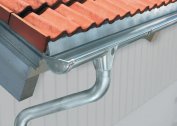To the sewage device - storm, drainage, fecal - there are certain requirements. These are not just instructions - the comfort of people living in a private house, as well as the level of environmental pollution, depend on their functioning. If the house does not have a central water supply, but consumes water from its own well in the area, it is important to make sure that the drinking water is not contaminated with sewage.
Private sewer requirements
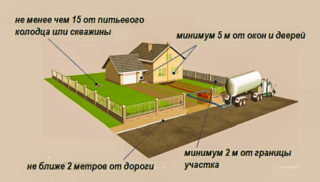 The main requirements are presented to the following points:
The main requirements are presented to the following points:
- outlet pipe width;
- the distance between the house and the septic tank, as well as to the level of groundwater;
- the presence of ventilation;
- number of wells for wastewater treatment;
- distance from a septic tank to a drinking well;
- the location of the pipes inside the house (wiring connected to a common riser);
- Depth of pipes outside the house.
The presence of inspection wells along the highway will be a plus if you have to clean the blockages. The layout of the sewage system in a private house is planned taking into account future repairs or prevention.
Guidelines for internal dimensions and angles
The width of the external line should be at least 15 cm. This is necessary so that the liquid in the pipes does not freeze in winter and passes faster through the site, and when large particles enter the sewer, there is no congestion.
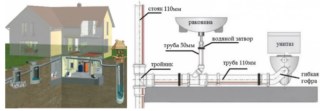 There are recommendations for arranging the internal wiring, by performing which you can avoid problems with the operation of the system:
There are recommendations for arranging the internal wiring, by performing which you can avoid problems with the operation of the system:
- The toilet is connected separately from the rest of the plumbing. The toilet pipe enters directly into the main riser.
- The diameter of the pipe of the main riser should be wider than the discharge of the toilet, which according to the norms should not be less than 10 cm wide.
- The distance from the toilet to the main riser is a maximum of 1 meter. The rest of the plumbing is up to 3 m.
- All plumbing is connected above the toilet connection point. In the event of a blockage, water pressure will help push it through.
The supply pipes from the well are best made the same size as the outlet pipes. Layers should not be thinner than eyeliners.
Tilt angles of pipes depending on their diameter:
- if the diameter of the pipe is 5 cm, then it is tilted by 3 cm every meter;
- 10 to 11 cm wide require a slope of 2 cm per linear meter;
- 16 cm diameter - 1 cm slope.
Do not rotate pipes 90 degrees. In this place, the probability of clogging is always higher. For pipe turns, angles of 135 degrees are suitable to ensure a smooth flow of fluid.
Every 15 m of the highway, inspection wells are arranged, so that in case of clogging of one section, it would be easier to get to it from the outside.
Ventilation, siphon and check valve requirements
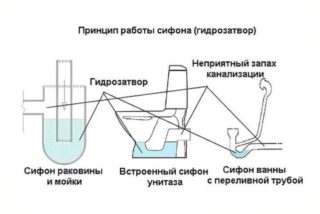 The ventilation pipe is led to the roof in a separate riser. You can not combine it with air ventilation at home, as sewage odors will penetrate into every room where there is an influx of air. You can get rid of the problem by completely rebuilding the system.
The ventilation pipe is led to the roof in a separate riser. You can not combine it with air ventilation at home, as sewage odors will penetrate into every room where there is an influx of air. You can get rid of the problem by completely rebuilding the system.
When leaving the house, it is necessary to install a check valve, which prevents sewage from entering the house back. Most often the pipes exit through the basement. In the event of an overflow, sewage will flood the basement.
A siphon is installed on each plumbing device in the house - these are pipes curved in the shape of the letter U. When there is always water there, it prevents odors from entering the house. However, if there is a siphon and there is no ventilation, the vacuum will remove water from the siphon with every flush, and it will not fulfill its function.The ventilation pipe in this case balances the pressure.
Types of sewer systems in a private house
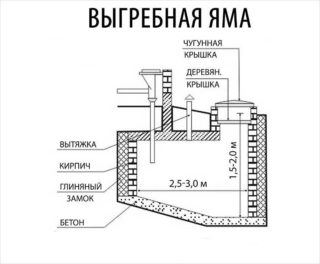 Depending on how much time you plan to spend in the house, choose one of the types of sewage devices:
Depending on how much time you plan to spend in the house, choose one of the types of sewage devices:
- accumulative septic tank - cesspool;
- treatment septic tanks - multilevel sewerage;
- Aerotank - biological wastewater treatment.
If the sewage system is designed for the summer period, it is enough to dig out a septic tank and concrete it or use ready-made concrete or plastic rings. To install concrete structures, you need equipment, plastic rings can be installed together. Both options are durable and reliable, last a long time and do not pollute the environment.
The minus of the cesspool with a blind bottom is the need for constant pumping. It will be necessary to call the cesspool machine often, which will require investment of financial resources. If you tighten with cleaning to save, odors will spread throughout the area. It is even possible overflow through the upper hatch.
Treatment septic tanks
This is a two or three level wastewater treatment system. The principle of operation is as follows:
- from the main riser, water and toilet waste fall into a sealed sump with a deaf bottom, where large particles settle to the bottom - there they are processed by bacteria that do not need air for life;
- the settled liquid flows into another tank, where aerobic microorganisms act on it and gradually organic residues are oxidized;
- 70% purified liquid is absorbed into the soil, since the bottom of the second tank is perforated or completely absent.
The advantage of the system is the independent operation of the device. If necessary, install an additional pump, but usually the overflow effect is achieved by a different level of pipe installation. It is not necessary to pump out waste from the first tank as often as from a cesspool. When biological activators are added, the resulting organics are used as fertilizer for the garden.
Cons of the system:
- the best degree of absorption is possible on sandy soil, but on loams and clay soils the soil can hardly pass liquid - up to 5 liters per day - this is extremely small for a private house;
- if the groundwater is high, the contaminated liquid may enter drinking water;
- during installation and planning, you will have to follow a lot of sanitary rules and norms.
Due to the type of soil in the plot, this type of septic tank may not take root, therefore, specialist consultation is necessary. It is important to make the sewage system in a private house correctly so that there are no problems with operation.
Aerotank
This is a volatile wastewater treatment method. In order for the unit to work efficiently, there should be no interruptions with the electrician, drains must be supplied continuously. The most important requirement is to maintain a balance between the amount of sludge, which acts as a biological filter, and toxic waste.
Aerotank works as follows:
- Contaminated sewage fluid enters the settling tank.
- Sewage is pumped into a second tank, where it is mixed with sludge. Here, oxygen is injected for the efficient operation of aerobic microorganisms.
- When the oxidation of organic residues is completed, water is pumped to the next tank, and the sludge returns to its place.
- After the second tank, the effluents are cleaned by 98% and can be used as process water - for plumbing, watering beds, washing machines.
There are many types of aeration tanks, but they all work on the same principle. The difference in the number of cleaning steps, unit power, additional technologies for the regeneration of a biological filter - sludge.
Aeration is a prerequisite, otherwise microorganisms will die from a lack of oxygen, will not be able to multiply and actively oxidize organics.
Advantages of the system:
- High quality wastewater treatment - water can be reused for the needs of the site.
- Small size - installed even on a small area.
- It does not need heating, since energy is released during oxidation and the temperature regime is maintained naturally.
- There are no unpleasant odors.
Of the minuses we can distinguish:
- The device must be used constantly - interruptions in operation can be a maximum of three months. Further, microorganisms die. Such a system is not suitable for country houses, where the sewage system operates only in the summer.
- This is a fairly complex equipment, so you need to constantly monitor it.
- High prices.
In the process, the device uses electricity, so its installation will require constant voltage in the network. You may need an independent battery.
Design and necessary calculations
Planning for the installation of a sewer in a private house:
- Locate each plumbing device in the house.
- They calculate the diameter of the internal wiring pipes, the distance to the main riser and the type of fastening. Calculate the approximate consumption of materials and fittings.
- Choose the type of sewage system depending on soil properties and financial capabilities.
- Determine the installation site of the main riser. Usually its location depends on the toilet. If there are two or more, they are in a different vertical plane, then the risers also need to do two or more. It is advisable to plan bathrooms over each other if the house is two-story.
- The highway is planned in such a way that it turns out less turns and angles. So you can avoid blockages.
With proper calculations, the system will work without interruption, even if temporary overloads occur.
Material selection
For all devices inside the house, a pipe with a diameter of 5 cm is suitable. For a toilet, you need 10 - 11 cm. The main riser is 15 cm. The pipe material - polyvinyl chloride - is the lightest, cheapest and most durable. Such parts can be joined by inserting the end of one part into another pipe. For sections with rotation, corner parts are used.
Sometimes sewage is made of cast iron, but it is more expensive. Installation of heavy material requires the use of force or special equipment. The plus is that it does not oxidize and is less susceptible to mechanical stress. Cast iron pipes do not like temperature changes, so they are additionally insulated with mineral wool.
During installation, tees - fittings - are useful for arranging wiring, as well as adapters for joining pipes of larger and smaller diameters.
Features and stages of sewage installation
 The internal and external sewers begin to equip at the same time. The inner pipes are laid and connected in accordance with the rules at the stage of laying the foundation. At the junction of the internal and external highways, a corrugated pipe is used so that when the building sags, there are no deformations of the structure.
The internal and external sewers begin to equip at the same time. The inner pipes are laid and connected in accordance with the rules at the stage of laying the foundation. At the junction of the internal and external highways, a corrugated pipe is used so that when the building sags, there are no deformations of the structure.
The septic tank is equipped first of all, since this is the most voluminous part of the work. The cesspool must be dug, bring concrete or plastic rings and lay them. If the septic tank is made of brick, it will take even more time, since it must be laid out and concreted, then allowed to dry.
For the external line, it is necessary to prepare a trench in which the sewer will be laid at a certain angle. Depth is calculated based on the distance between the house and the septic tank. Usually it does not exceed 10 meters. Longer sections are additionally insulated so that in winter the liquid does not harden.
When everything is ready inside and out, the segments are connected, and the trench and pit for the septic tank are covered with soil and rammed.
It is recommended that the sewage plan be maintained so that in case of land work on the site, the laid pipes will not be damaged.
After the construction of the house, the eyeliners are connected to siphons and plumbing.This is the end of the sewage system.
Operation and maintenance
After installing the sewage system, its operation is checked: several buckets of water are poured through the upper pipe and watch how it flows into the settling tank or cesspool.
If the system was mounted with engineering violations, then after some time a problem may arise in the form of a blockage or depressurization of the structure. In this case, you will have to open the underground highway and look for a place of leakage or blockage of the pipe. In order not to do this, it is better to listen to the advice of specialists and equip viewing wells through which you can clean the pipe section.
With mechanical damage to the line, there is only one way out - dig up the entire pipe, find the damaged place and replace part of the line.
The cost of laying sewage in a private house
The price of installing sewage in a private house depends on its type. There are very cheap options that run independently. They are suitable for a country cottage, but not for permanent residence.
The amount of consumables in a two-story house will be greater, therefore, construction will cost more. The presence in the house of many household appliances and sanitary equipment - toilets, sinks, bathtubs, showers requires more pipes and connecting elements. For insulation, you will have to buy special material, the amount of which depends on the length of the street highway.
If the installation is made with violations, then the sanitary and epidemiological station may write a fine, which will make the sewer system of the house even more expensive. Especially if waste water enters a nearby body of water.
Sewer system, as well as gas, electric, water, refers to utilities. Its installation is a crucial moment of construction, on which the durability of the entire structure will depend. You should not save on those things that should last for decades, because repair is a loss of finance and time, which after some time may not be there.
